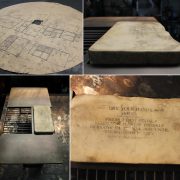Lithography
Invented in 1798, lithography is the process of producing a picture or writing using a flat, prepared stone. It was invented as a cheap way to print theatrical works. Originally, oil or another greasy substance was used on a lithographic limestone tab to produce these works.
Until the turn of the 20th century, the only commercial source of lithographic limestone was in Brandenburg, Kentucky.
At Fortin Ironworks, we appreciate the history antiques carry and the stories they tell. The lithographic stones used to make the tables for sale at Fortin Ironworks came from Northeast Ohio. They are from the early 20th century. The stones come in various shapes and sizes, each with different designs on them. This adds to the uniqueness of each individual piece of furniture. No two are alike!
Derek, one of our designers at Fortin Ironworks, came up with the idea of incorporating each of the stones as just a piece of the table. This was because many of the stones are too small to make stand-alone tabletops. He became creative and changed the design of each table according to the shape of the stone. Derek had to draw many sketches of the tables before he starting working on them to make sure everything would come out perfectly.
This is where the idea of incorporating iron came into play. Not only does it serve a purpose, but is also visually pleasing. The lightness of the iron rods on the table lay well against the heaviness of the stone. They also function as a magazine holder!
The iron on the tables was treated with a hand-rubbed black steel finish and a control rusting, also known as oxidation, process. This is what gives it its “Patina” design appearance.
Derek was able to turn six lithographic stones each into different tables in just eight days!



